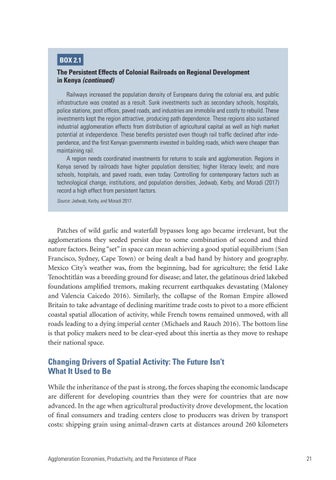BOX 2.1 The Persistent Effects of Colonial Railroads on Regional Development in Kenya (continued) Railways increased the population density of Europeans during the colonial era, and public infrastructure was created as a result. Sunk investments such as secondary schools, hospitals, police stations, post offices, paved roads, and industries are immobile and costly to rebuild. These investments kept the region attractive, producing path dependence. These regions also sustained industrial agglomeration effects from distribution of agricultural capital as well as high market potential at independence. These benefits persisted even though rail traffic declined after independence, and the first Kenyan governments invested in building roads, which were cheaper than maintaining rail. A region needs coordinated investments for returns to scale and agglomeration. Regions in Kenya served by railroads have higher population densities; higher literacy levels; and more schools, hospitals, and paved roads, even today. Controlling for contemporary factors such as technological change, institutions, and population densities, Jedwab, Kerby, and Moradi (2017) record a high effect from persistent factors. Source: Jedwab, Kerby, and Moradi 2017.
Patches of wild garlic and waterfall bypasses long ago became irrelevant, but the agglomerations they seeded persist due to some combination of second and third nature factors. Being “set” in space can mean achieving a good spatial equilibrium (San Francisco, Sydney, Cape Town) or being dealt a bad hand by history and geography. Mexico City’s weather was, from the beginning, bad for agriculture; the fetid Lake Tenochtitlán was a breeding ground for disease; and later, the gelatinous dried lakebed foundations amplified tremors, making recurrent earthquakes devastating (Maloney and Valencia Caicedo 2016). Similarly, the collapse of the Roman Empire allowed Britain to take advantage of declining maritime trade costs to pivot to a more efficient coastal spatial allocation of activity, while French towns remained unmoved, with all roads leading to a dying imperial center (Michaels and Rauch 2016). The bottom line is that policy makers need to be clear-eyed about this inertia as they move to reshape their national space.
Changing Drivers of Spatial Activity: The Future Isn’t What It Used to Be While the inheritance of the past is strong, the forces shaping the economic landscape are different for developing countries than they were for countries that are now advanced. In the age when agricultural productivity drove development, the location of final consumers and trading centers close to producers was driven by transport costs: shipping grain using animal-drawn carts at distances around 260 kilometers
Agglomeration Economies, Productivity, and the Persistence of Place 21

